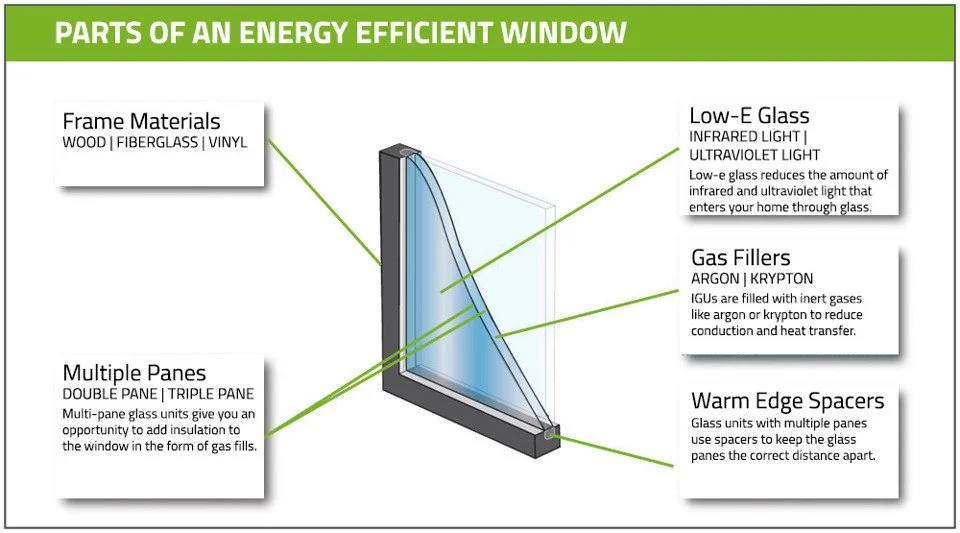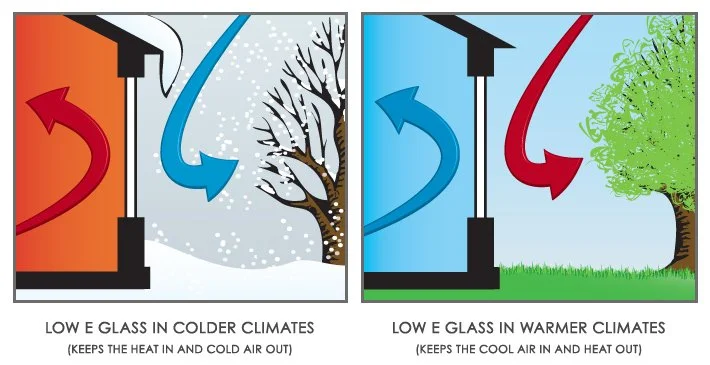Energy Efficient Windows: A Guide to Saving Money and Energy
Energy-efficient windows are a smart investment that can significantly impact your home's comfort and energy bills. By understanding the key factors that contribute to window efficiency, you can make informed decisions when choosing your new replacement windows.
Key Components of Energy Efficient Windows
Glazing: The glass in your windows plays a crucial role in energy efficiency.
Low-E Coatings: These microscopic metal or metallic oxide layers are applied to the glass to reduce heat transfer. Low-E coatings can be designed to reflect heat in summer and retain it in winter.
Insulating Glass: Double-pane or triple-pane windows offer better insulation than single-pane windows. The space between the panes is filled with a gas like argon or krypton to further reduce heat transfer.
Frame Material:
Vinyl: Known for its affordability and energy efficiency, vinyl frames provide good insulation.
Fiberglass: Offers superior insulation and durability compared to vinyl, but typically comes with a higher price tag.
Wood: While aesthetically pleasing, wood frames can be energy inefficient unless properly sealed and insulated.
Window Installation:
Proper installation is crucial for energy efficiency. Gaps and air leaks around the window frame can significantly reduce performance. Ensure your windows are installed by a qualified professional.
Energy Efficiency Ratings
U-factor: measures how well a product can keep heat from escaping from the inside of a room. The lower the number, the better a product is at keeping heat in.
Range: 0.20–1.20 Look for: Low numbers
Solar Heat Gain Coefficient (SHGC): measures how well a product can resist unwanted heat gain, which is especially important during summer cooling season. The lower the number, the less you’ll spend on cooling.
Range: 0–1 Look for: Low numbers
Visible Transmittance: measures how well a product is designed to effectively light your home with daylight, potentially saving you money on artificial lighting. The higher the number, the more natural light is let in.
Range: 0–1 Look for: High numbers
Air Leakage: measures how much air will enter a room through a product. The lower the number, the fewer drafts you’ll experience.
Range: ≤ 0.3 Look for: Low numbers
Top Contenders for Energy Efficiency
Casement Windows: These windows open outward on hinges, creating a tight seal when closed. This design minimizes air leakage, making them highly energy efficient.
Awning Windows: Similar to casement windows, awning windows open outward, providing a secure seal when closed. They also offer excellent ventilation while keeping rain out.
Fixed Windows: While offering no ventilation, fixed windows (like picture windows) can be highly energy efficient due to their lack of moving parts and potential for larger glass areas with advanced glazing technologies.
Most Energy-Efficient Window Styles
While all windows can be made energy efficient with proper glazing and installation, certain styles inherently offer better performance due to their design.
Less Energy-Efficient Options
Double Hung Windows: While popular for their versatility, double-hung windows can be less energy efficient due to the meeting rail, which can allow air leakage. However, modern double-hung windows with improved weatherstripping and glazing can mitigate this issue.
Sliding Windows: Similar to double-hung windows, sliding windows can have gaps around the edges, allowing air to infiltrate. Newer models with improved seals can enhance energy efficiency.
Window Frame Materials: Impact on Energy Efficiency
The material used for your window frame significantly influences its energy efficiency. Here's a breakdown of common window frame materials and their impact on your home's energy consumption
Vinyl
Energy Efficiency: Excellent insulator, resists heat transfer.
Durability: Resistant to rot, decay, and insects.
Maintenance: Low maintenance, doesn't require painting or staining.
Cost: Affordable.
Aluminum
Energy Efficiency: Poor insulator, conducts heat easily.
Durability: Resistant to weather and corrosion.
Maintenance: Low maintenance, doesn't require painting or staining.
Cost: Relatively affordable.
Fiberglass
Energy Efficiency: Superior insulation, offering better resistance to heat transfer than vinyl.
Durability: Highly durable, resistant to rot, decay, and insects.
Maintenance: Low maintenance, doesn't require painting or staining.
Cost: More expensive than vinyl but often less than wood.
Wood
Energy Efficiency: Good insulator, but requires proper sealing and maintenance to maintain efficiency.
Durability: Susceptible to rot, decay, and insect damage if not properly maintained.
Maintenance: Requires regular painting or staining to protect the wood.
Cost: Generally more expensive than vinyl or fiberglass.
Composite
Energy Efficiency: Good insulator, often combines the benefits of wood and vinyl.
Durability: Resistant to rot, decay, and insects.
Maintenance: Low maintenance, doesn't require painting or staining.
Cost: More expensive than vinyl but often less than wood.
Important Note
While the frame material is crucial, the overall energy efficiency of a window depends on several factors, including glazing, installation, and weatherstripping.
Additional Tips for Energy Efficiency
Window Treatments: Energy-efficient window treatments like blinds, shades, or curtains can further reduce heat gain or loss.
Proper Sealing: Ensure your windows are properly sealed to prevent air leaks. Caulk and weatherstripping can significantly improve energy efficiency.
Window Placement: Consider the orientation of your windows and how they interact with sunlight. Proper window placement can help maximize natural light while minimizing heat gain or loss.
By investing in energy-efficient windows and incorporating these additional tips, you can significantly reduce your energy consumption and create a more comfortable living environment.



